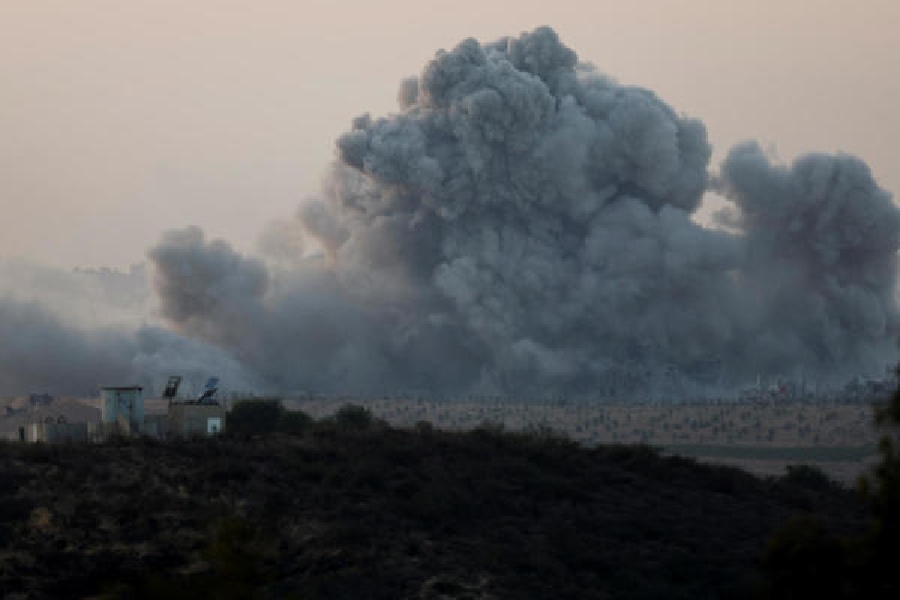Standing in front of a grey backdrop decorated with Hamas logos and emblems of a gunman that commemorate the bloody October 7 attack on Israel, Osama Hamdan, the organisation’s representative in Lebanon, professed no concern about his Palestinian faction being dislodged from the Gaza Strip.
“We are not worried about the future of the Gaza Strip,” he recently told a crowded news conference in his offices in Beirut’s southern suburbs. “The decision-maker is the Palestinian people alone.”
Hamdan thus dismissed one of Israel’s key objectives since the beginning of its assault on Gaza: to dismantle the political and military organisation that was behind the massacre of about 1,200 people, according to Israeli officials, and which still holds more than 100 hostages.
Israeli Prime Minister Benjamin Netanyahu has repeatedly emphasised that objective even while facing mounting international pressure to scale back military operations. The Biden administration has dispatched senior envoys to Israel to push for a new phase of the war focused on more targeted operations rather than sweeping destruction.
And critics both within Israel and outside have questioned whether resolving to destroy such a deeply entrenched organisation was ever realistic. One former Israeli national security adviser called the plan “vague”.
“I think that we have reached a moment when the Israeli authorities will have to define more clearly what their final objective is,” French President Emmanuel Macron said this month. “The total destruction of Hamas? Does anybody think that’s possible? If it’s that, the war will last 10 years.”
Since it first emerged in 1987, Hamas has survived repeated attempts to eliminate its leadership. The organisation’s very structure was designed to absorb such contingencies, according to political and military specialists. In addition, Israel’s devastating tactics in the war with Hamas threaten to radicalise a broader segment of the population, inspiring new recruits.
Analysts see the most optimal outcome for Israel probably consisting of degrading Hamas’ military capabilities to prevent the group from repeating such a devastating attack. But even that limited goal is considered a formidable slog.
Hamas is rooted in the ideology that Israeli control over what it regards as Palestinian land must be opposed by force, a tenet likely to endure, experts said.
“As long as that context is there, you will be dealing with some form of Hamas,” said Tahani Mustafa, senior Palestine analyst at the International Crisis Group think tank. “To assume that you can simply uproot an organisation like that is fantasy.”
The Israeli military said this week that it had killed about 8,000 Hamas fighters out of a force estimated at 25,000 to 40,000. But it is unclear how the count is being made. About 500 have surrendered, according to the military, though Hamas has denied that all were from its ranks.
The military has at times delivered positive progress reports on its objectives, describing as “imminent” full control over the areas in northern Gaza where it began its ground offensive in late October.
But Netanyahu acknowledged on Sunday that the war “is exacting a very heavy cost from us” as the military announced that 15 soldiers had been killed in the previous 48 hours alone. Rockets are still being fired almost daily from southern Gaza into Israel, albeit far fewer than before.
Michael Milshtein, a former senior intelligence officer for Israel, criticised statements by some Israeli leaders depicting Hamas as being at its breaking point, saying that might create false expectations about the length of the war.
“They’ve been saying this for a while, that Hamas is collapsing,” Milshtein said. “But it’s just not true. Every day, we’re facing tough battles.”
The Israeli military distributed flyers in Gaza recently offering cash for information leading to the arrest of four Hamas leaders.
“Hamas has lost its power. They couldn’t fry an egg,” said the flyer in Arabic, quoting a folk expression. “The end of Hamas is near.” The military promised $400,000 for Yahya Sinwar, Hamas’ leader in Gaza, and $100,000 for Mohammed Deif, head of its military wing, the Qassam Brigades. The two are considered the architects of the October 7 attack.
Although long among the most wanted men in Gaza, the elusive Deif has avoided assassination or capture. The only picture of him in public is a decades-old headshot.
The bounties appeared to be another indication that Israel is struggling to remove the Hamas leadership.
The group’s top echelon is believed to be sheltering, along with most of its fighters and the remaining hostages, in deep tunnels. Although the Israeli army has said that it demolished at least 1,500 shafts, experts consider the underground infrastructure largely intact.
The tunnels, built over 15 years, are believed to be so extensive, estimated at hundreds of miles long, that Israelis call them the Gaza Metro.
“Hamas is actually weathering this assault quite well,” said Tareq Baconi, an author who wrote a book about the group. “It’s still showing that it has an offensive military capability.”
The operations of the Hamas military wing, the Qassam Brigades, remain opaque. The units were designed to continue functioning even if Israel destroyed parts.
Divided geographically, its five main brigades were in northern Gaza; Gaza City; central Gaza; and two southern cities, Khan Younis and Rafah.
Most of the elite troops were in the two northern brigades, which constitute about 60 per cent of the force, said an Israeli military official who requested anonymity under military regulations. About half of them have been killed, wounded, arrested or fled south, the official claimed.
For Israel, the aim is first to dismantle the government, then to disperse the fighters and eliminate the commanders and their primary subordinates, the Israeli official said.
But Azzam Tamimi, a Palestinian journalist and member of the Muslim Brotherhood who has written a book about Hamas, said the group was prepared for that.
“The top leadership can disappear at any time because they can be killed, they can be arrested, they can be deported,” he said. “So they developed this mechanism of the easy transfer of command.”
The Qassam Brigades are divided into battalions, with even smaller units defending individual neighbourhoods. Other specialised battalions include an anti-tank unit, a tunnel-construction unit and an air wing whose drones and paragliders were an important element of the surprise attack on October 7, according to analysts and former military and intelligence officials.
The Nukhba Brigade, consisting of about 1,000 highly trained fighters, also appears to have played a central role on October 7.
Trying to eliminate Hamas entirely would require fighting from street to street and house to house, and Israel lacks both the time and personnel, said Elliot Chapman, a West Asian analyst with Janes.
As the US found in attempting to squash al Qaida or the Taliban, the organisations tend to spring back once the armed pressure is lifted. The Gaza fight has been compared with the campaign to wrest Mosul, Iraq, from the Islamic State group less than a decade ago, but there are significant differences.
Notably, Hamas is organic to Gaza — it grew out of frustration with the factions abandoning the armed struggle against the Israeli occupation. At best, Israel can probably contain Hamas, experts said.
New York Times News Service











